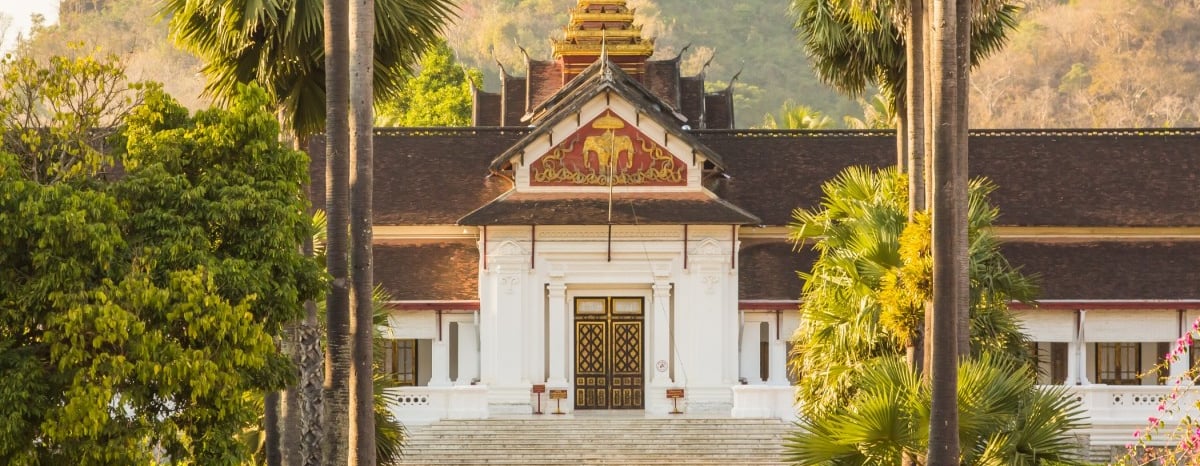2025 August
Know Before you Go: Laos Edition + Sample Itineraries
by Evi


Tucked between Thailand, Vietnam, Cambodia, and China, Laos is one of Southeast Asia’s most underrated gems, a land of golden temples, French colonial charm, slow-flowing rivers, and breathtaking nature. Unlike its bustling neighbors, Laos moves at a slower, more peaceful pace, offering travelers the chance to truly unwind while still diving deep into rich history and culture. But before you go, it’s important to know a few practical things that will make your trip smoother, from money and visas to local etiquette, transport tips, and what to pack. Here’s your essential guide to preparing for Laos.


1. Money
Laos’ official currency is the Lao Kip (LKP), though Thai Baht and US Dollars are also widely accepted, especially in tourist areas. ATMs are common in major cities like Vientiane, Luang Prabang, and Pakse, but they often have withdrawal limits 3,000,000 LKP (~90–130 EUR), so plan ahead if you need larger amounts of cash. BCEL ATMs are the most reliable for foreign cards.
Credit cards are accepted in higher-end hotels and restaurants, but cash is king for local markets, transport, and smaller eateries. It’s best to carry a mix of kip and dollars for flexibility. Where to Exchange Money in Laos: in Banks: BCEL (Banque Pour Le Commerce Exterieur Lao) and ACLEDA are the most reliable. Branches are in all major cities, including Luang Prabang, Vientiane, and Pakse. Authorized Money Changers: Found around Luang Prabang Night Market, Vientiane city center, and at border towns. Rates are often slightly better than banks. Hotels & Airports: Convenient but offer the worst rates. Only use if you urgently need cash upon arrival.
Tip for Euro travelers: Bring clean €50 and €100 notes for the best exchange rates. Small bills are accepted but often at a lower rate.
Pro Traveler Tip: If you’re coming from Thailand, it’s often cheaper to withdraw Thai Baht from Thai ATMs (which have higher limits and lower fees) and exchange them for Kip in Laos at a border or city money changer.
2. How to Stay Connected
Staying connected in Laos is easy with local SIM cards or eSIMs, which are affordable and offer good coverage in cities and towns. Providers like Unitel, Lao Telecom, and ETL sell prepaid SIMs at airports and convenience stores. For even more convenience, you can purchase an eSIM online like Revolute, Airalo or Nomad before you arrive. Wi-Fi is widely available in hotels, cafés, and restaurants, though speeds can vary. Having mobile data is recommended, especially if you plan on using ride-hailing apps or navigation on the go.
3. How to Get Around Within Cities
Cities in Laos are compact and easy to explore. Tuk-tuks and songthaews (shared trucks) are traditional options, but in recent years, ride-hailing apps like Loca (Laos’ homegrown app) and InDrive have become popular for their convenience and transparent pricing. Walking and cycling are great for smaller towns like Luang Prabang, while renting a motorbike is a budget-friendly option if you’re comfortable with traffic and road conditions.


4. How to Get From City to City
Getting around Laos has become much easier in recent years, thanks to the new high-speed train, modern buses, and reliable domestic flights. Here’s a breakdown of how to move between the country’s main destinations:
Vientiane ⇄ Luang Prabang
By Train: The fastest and most comfortable way is the Laos–China Railway, connecting the capital to Luang Prabang in just 2 hours. Trains are modern, clean, and punctual. Tickets cost around 20–35 euro depending on class.
Book in person at the station, through local travel agencies, or online via 12go.asia.
By Bus: Overnight sleeper buses take 9–11 hours. Cheaper than trains (15 euro), but less comfortable.
By Plane: Laos Airlines and Lao Skyway run short flights (~45 minutes). Convenient, but usually more expensive than trains.
Vientiane ⇄ Pakse (Southern Laos)
By Plane: The quickest way (1 hr 30 min). Laos Airlines operates direct flights several times per week.
By Bus: Overnight buses take 10–12 hours. VIP or sleeper buses are the most comfortable option. You can book at local stations or on 12go.asia.
By Train: No train line yet to Pakse—flights or buses are the best bet.
Luang Prabang ⇄ Nong Khiaw & Muang Ngoi (Northern Laos)
By Bus/Minivan: Around 3–4 hours to Nong Khiaw. From there, you can take a boat to Muang Ngoi, a remote riverside village.
Book through your guesthouse or a local agency.
Luang Prabang ⇄ Huay Xai (Thai Border, Slow Boat Route)
By Slow Boat on the Mekong: One of the most scenic journeys in Southeast Asia. Two days, with an overnight stop in Pakbeng. Book through Mekong Cruises.
Vans connect Chiang Rai/Chiang Khong (Thailand) to the Lao border at Huay Xai, where you board the boat.
Tickets and transfers can be booked on 12go.asia or via local tour operators.
Vientiane ⇄ Siem Reap/Phnom Penh (Cambodia)
By Plane: Laos Airlines and Cambodia Angkor Air operate direct flights (1–2 hours).
By Bus: Long but cheap option (~24 hours to Phnom Penh). Buses pass through Pakse and the Laos–Cambodia border crossing at Nong Nok Khiene.
Vientiane ⇄ Hanoi (Vietnam)
By Plane: Quick and easy (1 hr 10 min).
By Bus: Budget-friendly but long and tiring (22–24 hours). Popular with backpackers, but only recommended if you have the stamina.
Luang Prabang ⇄ Hanoi / Dien Bien Phu (Vietnam)
By Plane: Direct flights to Hanoi several times per week.
By Bus (to Dien Bien Phu): Around 9–10 hours through winding mountain roads. A true backpacker route.
Booking Tips
12go.asia is the most reliable website for trains, buses, and boats in Laos. You can compare schedules and prices and book tickets in advance.
Domestic flights can be booked on airline websites like Laos Airlines or Lao Skyway.
For buses and slow boats, guesthouses and travel agencies in tourist areas also sell tickets (often with hotel pickup).


5. Is It Safe?
Laos is generally a safe country for travelers, with low crime rates and friendly locals. Petty theft and scams can happen, particularly in tourist areas, so keep an eye on your belongings and agree on tuk-tuk fares in advance if not using apps. Roads can be less safe due to traffic conditions, so take care when riding motorbikes or crossing streets. Natural risks like strong river currents or slippery paths near waterfalls also call for caution.
6. How to Obtain a Visa
Most travelers need a visa to enter Laos, but the process is straightforward. EU passport holders, along with many other nationalities, can apply for a visa on arrival at major airports (Vientiane, Luang Prabang, Pakse) and most land borders, or apply in advance for an eVisa online through the official Lao eVisa website here. You’ll need a valid passport (with at least six months validity), a passport photo, and a fee (around USD 50 depending on nationality). The visa typically allows a 30-day stay.
7. Laos Etiquette and Culture
Laos is a deeply spiritual country, with Theravada Buddhism shaping much of daily life. Temples (called wats) are everywhere, and you’ll notice orange-robed monks walking the streets each morning for alms. When visiting, dress modestly (cover shoulders and knees), remove your shoes before entering, and avoid touching monks if you’re a woman. Greeting locals with a nop (hands pressed together in front of the chest, like a prayer gesture) is a respectful alternative to handshakes. Lao people value politeness and calmness, raising your voice or losing your temper is considered very disrespectful.


8.Weather & When to Travel & What to Pack
Laos has a tropical monsoon climate with three distinct seasons. The cool and dry months from November to February are the best time to visit, with pleasant temperatures between 15–25°C and clear skies, ideal for exploring Luang Prabang or trekking in the mountains. From March to May, the weather turns hot and dry, often soaring past 35°C, which makes sightseeing harder but is great for enjoying waterfalls or river tubing. The rainy season from June to October brings lush green landscapes and fewer tourists, though rural roads can get muddy. Packing wisely is key: bring lightweight clothes for the heat, a sweater or jacket for cooler evenings, a raincoat if traveling in monsoon season, and a mix of sandals and sneakers for both city and outdoor adventures. Don’t forget respectful clothing that covers shoulders and knees for temple visits.
9. Food & Drinking Culture
Food in Laos is more than just nourishment, it’s about community and sharing. Meals almost always center around sticky rice (khao niao), eaten with the hands and paired with fresh, herby dishes like larb (a minced meat salad), mok pa (fish steamed in banana leaves), or lam (a hearty stew from Luang Prabang). Street food stalls are everywhere, serving everything from noodle soups and grilled skewers to fried snacks and tropical fruits. Beer Lao, the national pride, flows freely and is often drunk with ice cubes. Drinking is a social act, with endless “nok!” (cheers) shared among friends. If you’re invited to eat with locals, wait until your host begins before you start, and always use your right hand when sharing food or passing dishes.
10.Power Plugs
Electricity in Laos runs at 230V, 50Hz, and plugs are a mix of Type C, E, and F (the same as in much of Europe) as well as the occasional Type A or B (like the US). Most European travelers won’t need a converter, but since outlets vary, bringing a universal travel adapter is a smart idea. Power cuts are not unusual in smaller towns, so if you rely on electronics, a small power bank is worth packing.
11. Essentials & What to Bring from Europe
While many basics are available in Laos, some things are difficult to find or expensive compared to Europe. Bring any personal medications, plus essentials like ibuprofen, rehydration salts, and allergy tablets. Mosquito repellent and after-bite cream are a must, given the risk of dengue and malaria in some areas. Sunscreen is pricey and often lower quality, so it’s better to pack it from home. Don’t forget travel insurance, healthcare is limited outside major cities, and comfort items like European snacks or chocolate if you get homesick.
12. In Case of an Emergency
Healthcare in Laos is improving but still limited, especially outside of Vientiane. In the capital, Mahosot Hospital and Alliance International Medical Centre are among the better facilities, but for serious emergencies, evacuation to Thailand (Bangkok or Chiang Mai) is common. Emergency numbers include 1191 for police, 1190 for fire, and 1195 for ambulances, though response can be slow. Pharmacies are widely available in towns and cities, but always check expiration dates on medicine. Carry a copy of your passport, insurance details, and keep your embassy’s contact handy in case you need assistance.


Laos offers a unique mix of history, culture, and natural beauty
Traveling to Laos is an unforgettable experience, filled with serene landscapes, rich traditions, and warm hospitality. While it remains one of Southeast Asia’s more laid-back destinations, being prepared makes your journey smoother. From understanding the currency and transportation options to respecting local etiquette and packing for the tropical climate, these practical tips will help you make the most of your visit. Whether you’re wandering the temples of Luang Prabang, cruising down the Mekong, or exploring the southern waterfalls of Pakse, Laos offers a unique mix of history, culture, and natural beauty that’s best enjoyed with an open heart and a curious spirit.


Itinerary 1: Laos in 4 Days – Quick Cultural & Nature Highlights
Day 1: Vientiane
Arrive in Vientiane and explore the city center.
Visit Pha That Luang, the golden stupa and national symbol.
See Patuxai, Laos’ version of the Arc de Triomphe.
Sunset along the Mekong Riverside Park with street food tasting.
Day 2: Vientiane → Luang Prabang
Fly or take a train to Luang Prabang.
Explore Wat Xieng Thong, Royal Palace Museum, and Phousi Hill at sunset.
Evening stroll through Luang Prabang Night Market.
Day 3: Luang Prabang & Surroundings
Witness the Tak Bat monk alms ceremony at sunrise.
Day trip to Kuang Si Waterfalls for swimming in turquoise pools.
Optional visit to Pak Ou Caves along the Mekong River.
Day 4: Luang Prabang → Departure
Morning visit to Heuan Chan Heritage House or local markets for souvenirs.
Fly or train back to Vientiane or onward to your next destination.


Itinerary 2: Balanced Laos – Culture & Nature (10 Days)
Day 1–3: Luang Prabang
Witness Tak Bat, explore Royal Palace Museum and Wat Xieng Thong.
Day trips to Kuang Si Waterfall, Tat Sae Waterfall, and Pak Ou Caves.
Evening at Luang Prabang Night Market.
Day 4–5: Vang Vieng
Take the train or bus to Vang Vieng
Cave exploration and adventure sports (kayak, tubing).
Hot air balloon ride and cycling around villages.
Day 6–7: Vientiane
Take the train or bus to Vientiane
Visit Pha That Luang, Patuxai, Wat Si Saket, and COPE Center.
Day 8–10: Southern Laos – Pakse & 4000 Islands (Si Phan Don)
Take a flight or bus to Pakse
Visit Wat Phou, a UNESCO World Heritage site.
Explore 4000 Islands, see Khone Phapheng Falls, and take a boat tour.
Relax, swim, or rent bikes around Don Det and Don Khone.


Drop us a comment bellow
Check our other post for Laos
Know Before you Go: Laos Edition + Sample Itineraries
Tucked between Thailand, Vietnam, Cambodia, and China, Laos is one of Southeast Asia’s most underrated gems, a land of golden temples, French colonial charm, slow-flowing rivers, and breathtaking nature. Unlike its bustling neighbors, Laos moves at a slower, more peaceful pace, offering travelers the chance to truly unwind while still diving deep into rich history and culture. But before you go, it’s important to know a few practical things that will make your trip smoother, from money and visas to local etiquette, transport tips, and what to pack. Here’s your essential guide to preparing for Laos.
Evi
8/17/20259 min read
